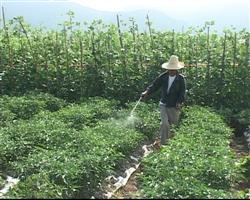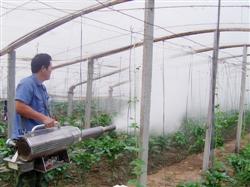What are the application methods of plant growth regulators?

What are the application methods of plant growth regulators? Please introduce that plant growth regulators are substances that have similar physiological and biological effects to plant hormones. At present, the substances widely used in agricultural production with plant growth and development functions are auxin, gibberellin, ethylene, cytokinin, abscisic acid, brassinolide, salicylic acid, jasmonic acid and polyamines, etc. it is suitable for field crops, vegetables, fruit trees, flowers, trees, etc., which is characterized by regulating plant photosynthesis, respiration, substance absorption and transport. The physiological processes such as signal transduction, stomatal opening and closing, osmotic regulation and transpiration control the growth and development of plants and improve the interaction between plants and the environment. Not only enhance the resistance of crops, but also improve the yield of crops and the quality of agricultural products. Favored by the majority of farmers, the main techniques are introduced as follows: 1, as a seed coating agent. It can be used as a special seed coating agent to wrap it around the seed to form a film with a certain thickness, which can not only promote seed germination, but also control diseases and insect pests, increase mineral nutrition and regulate plant growth. 2. Seed dressing. Seed mixing method and seed coating method are mainly used for seed treatment. When treating seeds with fungicides, pesticides and micro-fertilizers, plant growth regulators can be added appropriately. The seed mixing method is to mix the medicine with the seed, so that the appearance of the seed is stained with the medicament, such as spraying the agent on the seed with a sprayer, stirring evenly and sowing the seed. If seed is mixed with petroleum growth aid, it can stimulate seed germination and promote rooting. 3. Soaking method. In promoting the rooting of cuttings, seed treatment, ripening fruits, storage and preservation, such as woody cuttings with leaves, can be placed in 5 to 10 ml / L indolebutyric acid, soaked for 12 to 24 hours, directly inserted into the seedbed. Can also be used fast dipping method, such as naphthalene acetic acid and talcum powder according to 1 gram: 1000 grams mixed evenly, the lower part of the cuttings soaked with water, and then dipped in a little powder cutting in the seedbed. Fresh-keeping can be used for fresh cut flowers. The fresh flowers can be directly soaked in 10 ml / L dinitrophenol solution and stored at 2 ℃ to 5 ℃ low temperature to prolong the shelf life. 4. Solution spraying. According to the need to prepare the corresponding concentration of spraying plants, the liquid droplets are required to be small and uniform, with the wetness of the spraying site as the degree. In order to make the agent easy to adhere to the plant surface, a little emulsion, such as neutral washing powder or surfactant and other auxiliaries, can be added to the agent to increase the adhesion of the agent. 5. Soil irrigation. Plant growth regulators were mixed into aqueous solution and poured directly into the soil or mixed with fertilizers to make the roots fully absorbed. If potted flowers, the amount of solution required depends on the size of the plant and the basin, generally 9 to 12 cm caliber pot needs 200 to 300 milliliters. In order to promote plant flowering and control the elongation and growth of plant stems and branches, 0.1% to 0.3% succinic acid and dwarf acid aqueous solution can be used to irrigate. Click to get more regulator application techniques click to get more pesticide application techniques
- Prev

How do vegetables use plant growth regulators?
How do vegetables use plant growth regulators? Please give guidance on the application of plant growth regulators to vegetables can refer to the following methods: 1. According to the purpose of use, to determine the appropriate concentration of plant growth regulators should use different concentrations according to the purpose of use, different types of vegetables and different periods. ...
- Next

How to use plant growth regulators?
How to use plant growth regulators? Plant growth regulators are synthetic, artificially extracted exogenous substances with physiological activities of plant hormones, and very small amounts can promote or inhibit or hinder the growth and development of plants. Scientific and rational use of plant growth regulators is to achieve crop increase.
Related
- Fuxing push coffee new agricultural production and marketing class: lack of small-scale processing plants
- Jujube rice field leisure farm deep ploughing Yilan for five years to create a space for organic food and play
- Nongyu Farm-A trial of organic papaya for brave women with advanced technology
- Four points for attention in the prevention and control of diseases and insect pests of edible fungi
- How to add nutrient solution to Edible Fungi
- Is there any good way to control edible fungus mites?
- Open Inoculation Technology of Edible Fungi
- Is there any clever way to use fertilizer for edible fungus in winter?
- What agents are used to kill the pathogens of edible fungi in the mushroom shed?
- Rapid drying of Edible Fungi

